Future Improvements
Now
that I've discussed the different contrast ratios quite a bit, I want to
go through an example using the contrast calculator at http://home1.gte.net/res18h39/contrast.htm in relation
to the DLP class of projectors, where major investments are continuing
to be made toward future improvements. At this time it is not uncommon
for good home theater DLPs to be able to achieve 4000:1 On/Off CR and
500:1 ANSI CR. A person working on this class of projectors, or
customers, could ask themselves where they would like to see CR
improvements if they had to choose between improvements to On/Off CR or
to ANSI CR. It would be easy to say ANSI CR if a person is thinking
about mixed scenes, but On/Off CR can be a larger limiter of
simultaneous CR in dark mixed scenes.
I am going to start with those values of 4000:1 and 500:1
for projector A in that calculator, along with changing the gamma to
2.22. In this case, I am going to assume the darkest of rooms (or a
great screen for reducing the effect of reflections) and use 0.001 for
the room gain, which will give more weight to ANSI CR than a higher
value for room gain would. This results in the following checkerboard
CRs:
| IRE |
100 |
50 |
20 |
10 |
5 |
| CR |
400:1 |
298:1 |
105:1 |
34:1 |
11:1 |
From this, the simultaneous CR is still very good with the
50%stim/0%stim checkerboard and gets weaker as the level for the
brighter rectangles goes down. I will now check the estimates for those
same CRs if the ANSI CR were improved 8x all the way up to matching the
On/Off CR (which would imply almost no extra washout effect from bright
parts of the images to dimmer parts). For projector B, I enter the same
numbers as projector A, except for 4000:1 for the ANSI CR. This results
in the following checkerboard CRs:
| IRE |
100 |
50 |
20 |
10 |
5 |
| CR |
1334:1 |
623:1 |
128:1 |
36:1 |
12:1 |
We can see from these data that the simultaneous CRs that
were already very good went up, but there was very little improvement to
the simultaneous CRs where the most weakness was found. Now instead of
improving the ANSI CR, let's leave it at 500:1 and improve the On/Off CR
by the same 8x to 32,000:1. Plugging this in for projector B results
in:
| IRE |
100 |
50 |
20 |
10 |
5 |
| CR |
400:1 |
383:1 |
286:1 |
147:1 |
52:1 |
While this doesn't give the super high simultaneous CR for
the 100 IRE case, it is still very high, and the most improvement by far
has come at the weakest points. The checkerboard with 5 IRE (or 5%stim)
for the brighter rectangles had the CR go up to over 4x that from the
4000:1 On/Off CR, 500:1 ANSI CR and the 4000:1 On/Off CR, 4000:1 ANSI CR
cases. A person could plug in 4000/4000 for projector A and 32000/500
for projector B and be able to look at any of the levels in that
contrast calculator side-by-side.
I believe that many fewer
people would notice improvements to ANSI CRs that are already at 500:1
and above than to On/Off CRs that are in the 4000:1 range, and so I am
looking for improvements to On/Off CR from future models of those
projectors.
More Test Scenes
For
readers who would like to do a test of shadow detail in a mixed scene,
one that I like is in chapter 20 of the extended edition of Lord of
the Rings: The Two Towers (and an earlier chapter
with the regular version). I have included a shot of it here that
I ran a contrast enhancement on in order to make some of the detail more
visible under the various conditions that readers will have while
viewing it.
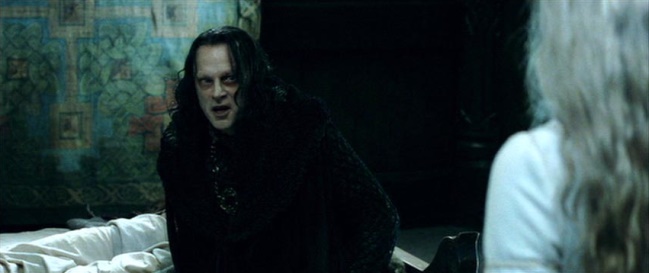
Copyright New Line Productions, Inc. and New Line Home
Entertainment, Inc.
The portions of the image I generally consider are the
front of Wormtongue's coat and the background between him and Eowyn. On
a display that is lacking in shadow detail in mixed scenes the front of
Wormtongue's coat can look like a black or gray hole with no detail.
Between them there is a door and what looks like a sculpture.
One
sequence I like to look at for seeing the effect of going from very dark
images with a small amount of light to similar images with some larger
bright objects in them, and back and forth, is during the opening
credits for The Last Starfighter. This sequence can show the
effect of the washout best described by ANSI CR on visible detail as
well as how our perceptions of blacks vary between different displays
based on their relative CR characteristics. Note that the screen shots
below have been lightened to make all the details visible on your
computer monitor, and they may appear pixelated on some monitors.
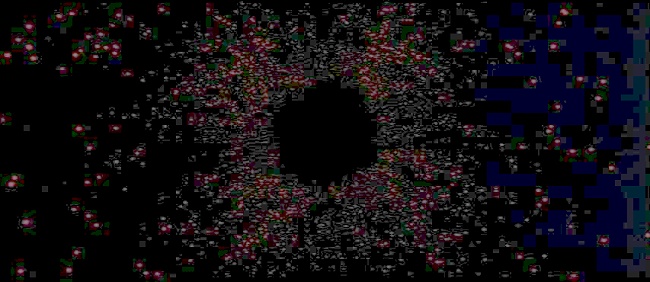
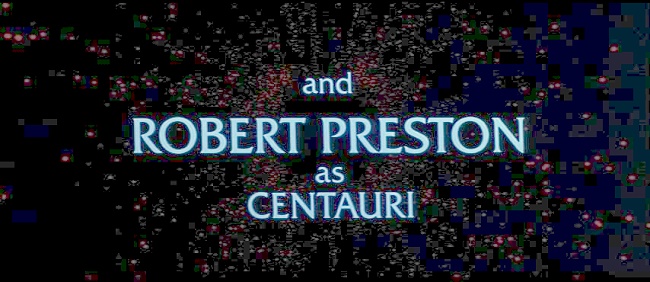
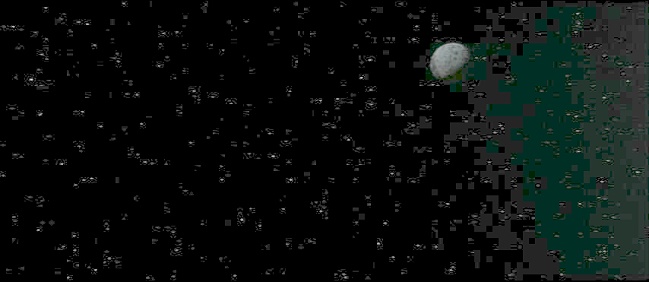
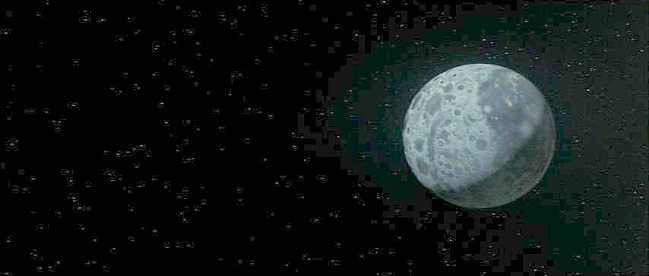
Copyright Lorimar/Universal Studios
The black level in the first image where there are only
stars will depend heavily on On/Off CR, while ANSI CR starts to come
into play much more as bright objects are added. The dominant one
between On/Off CR and ANSI CR for the second image will depend greatly
on the display and how it does for each of those. With images that are
strong in On/Off CR and weak in ANSI CR, the blacks can look black
during the images with just the starfield on black and then appear as more
of a gray when credits come up over the starfield. With images that are
weak in On/Off CR and strong in ANSI CR, the blacks can look gray during
the images with just the starfield on black and then look black
when credits come up over the starfield or a bright object comes in to the
images. Looking at which stars are visible and which are not during the
last three images can give an idea of how proximity to bright objects
affects the visibility of certain details on various displays.
Remember again that these are not things I am trying to demonstrate with the
images above as they appear on your computer monitor. I have included
them as references for which images I recommend looking at from the actual
DVD (or other source) at full size with actual displays, for those who want
to explore these effects further.
Accuracy in
Measurements
One thing to be aware of is that contrast
ratios with front projectors have gotten high enough that measuring them
accurately can be a challenge. Many of them have low enough absolute black
levels that measuring them will give unreliable results using most test
equipment, if care is not taken.
For instance, a measurement of 0.002 ft-lamberts with a tool
that only goes down to 0.001 has a huge margin of error. Please be
careful of trusting On/Off CR values with low black levels where caution
has not been taken to get reliable results. I tend to measure On/Off CR
by measuring close to the projector with a dedicated light meter. For
tools where measuring off a screen is necessary the projector can be
placed close to the screen to get smaller images that are brighter and
will give higher readings for the denominator (the black level) to help
the overall margin of error.
When a meter doesn't have a high
enough accuracy range to measure both 100%stim and 0%stim from one image
size or one location in front of the projector, it is possible to get
reliable results by breaking the measurements up. For instance, a person
could measure 20%stim and 0%stim from close to the projector and then
measure 100%stim and 20%stim from a further distance from the projector.
In that case, the 100%stim/0%stim CR would result from doing the
following calculation from those measurements: (100%stim/20%stim) *
(20%stim/0%stim).
Measuring ANSI CR accurately can also be a
challenge. For this, I tend to cover the screen with black velvet or a
dark sheet to keep room reflections to a minimum, and then
measure from the projector. For measuring ANSI CR
off screens I actually use a black velvet lined pipe made from black
poster-board on the front of a light-meter that points at the screen in
order to keep light from the brighter rectangles from throwing off the
readings of the darker rectangles. I found that without doing this, the
meter I use could not read above about 200:1 ANSI CR.
I also want to make sure that people understand that the
projector should be set up as it would be for viewing before taking the
relevant measurements for CR. It may seem obvious, but there should be
no standing in front of the projector to block the light from it,
covering the light with anything else (including a filter) between
measurements, or changing anything in the projector between measurements
(including the lens zoom or bulb setting). Any of those would pretty
much make the measurements worthless, although I'm sure that many
marketing departments are tempted to play tricks that are similar. I
consider things like dynamic irises which really do work on their own as
a viewer is watching a movie to be legitimate because they are part of
the video manipulation the projector performs, and the user isn't
changing anything in the projector between the measurements. The on/off
CR and ANSI CR measurements I do are with 100%stim and 0%stim for the
white and black levels (or video 235 and video 16 in 8 bit space),
although I may occasionally use a different level for one of them and
will specifically mention it if I do. For instance, if I use 109%stim
(or video 254 in 8 bit space) for a reading, I will mention
it.
Go
to Part VI.